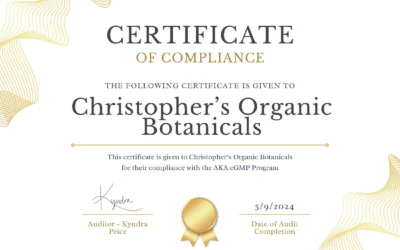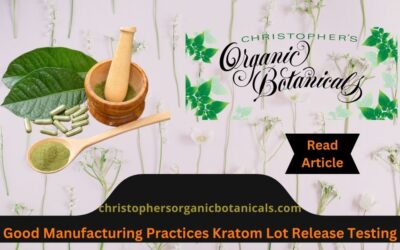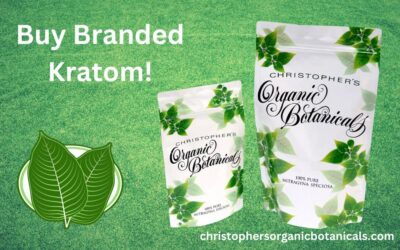Product Testing
Several products undergo quality testing before they hit the market. These include items like over the counter and prescription drugs, food, and beverages, and even cars and trucks. Kratom is no different; it is subject to kratom lab testing before it reaches the consumer.
Kratom quality testing can be done in-house or with an external third-party kratom testing laboratory to analyze products for pathogens, heavy metals, and pesticides, ensuring that labeling is clear and accurate. A reputable, dependable Kratom supplier must conduct proper testing on every product.
When you order speciosa powder from Christopher’s Organic Botanicals, they make certain it is free of any harmful chemicals or contaminants and that it is 100% Kratom leaf. Christopher’s biological Kratom Powder is 100% tested.
In this article, we will explain how quality-testing is used to ensure consumers get the best Kratom available.
The Processes for Quality Testing Kratom
It is important to understand how products are evaluated for quality. Some companies may use third-party laboratories, while others may complete tests in-house. In either case, it is important to find out if they have specific protocols for testing before you purchase their products.
The more reputable the company, the higher quality of their products will be—that means fewer fillers too! When buying from a reputable supplier, basic testing has been done already.
Testing for Plant Potency and Labeling
We evaluate Mitragyna Speciosa products to ensure that they contain only Kratom leaf powder and nothing else. The alkaloids levels in the powder are measured in a lab report to show how powerful it is. These alkaloids can be anywhere from .5% to 3%, depending on the strain and how potent and/or old the powder is.
Testing for Microbial Contamination
Microbial contamination in kratom can occur when there’s bacteria, yeast, or mold in the product. This can also happen if leaves are stored in moist areas with little ventilation where microbes have a chance to fester. When conducting a Kratom Test, it is crucial to analyze the microbial counts present in the product. The kratom test results should ideally indicate low microbial counts, which essentially means that the product contains minimal amounts of yeast, mold, or bacteria.
Microbial contamination in kratom can occur during various stages of its production, including harvesting, processing, packaging, and storage. Factors such as improper handling, inadequate drying, or unsanitary conditions can contribute to the growth of microorganisms in the product.
Yeast, mold, and bacteria are tiny living things in kratom. They grow in wet places and can make the kratom go bad, making it look, feel, and smell different. Additionally, they can produce toxins that may pose health risks if consumed.
Bacterial contamination in kratom can also be a concern as certain strains can cause foodborne illnesses. These bacteria can multiply rapidly under favorable conditions and may lead to symptoms such as nausea, vomiting, diarrhea, and abdominal pain if ingested.
To ensure the safety and quality of kratom products, it is essential to conduct regular tests to assess the microbial counts. Low microbial counts indicate that the product has undergone proper handling, processing, and storage, minimizing the risk of microbial contamination.
By keeping kratom products free from harmful bacteria, consumers can trust that the product they buy is safe and reliable. Manufacturers and suppliers need to prioritize quality control and adhere to good manufacturing practices. This is important in order to maintain the safety of kratom products by preventing the presence of germs. It is crucial to ensure the overall safety of these products.
Testing for Pathogens
We use pathogen tests to check for viruses, bacteria, yeast, and mold. Pathogens can be there if the plant or leaf has feces from an infected animal, human touch, or contaminated water.
Testing for pyrethroids and carbamates is done to find pesticide residue. These chemicals are commonly found in pesticide products. Pesticides can get onto kratom plants when they are directly applied or when nearby crops or trees are sprayed.
What Are Some Common Quality Tests for Kratom?
There are multiple tests used when testing the quality of Kratom. Many labs use different tests, and some may evaluate for more than we list here. They include:
Microbial tests to decide the presence of mold, yeast, or harmful bacteria. Screening tests can also be used to show specific pathogens. Potency/Residual Solvent tests to measure what percentage of a product is composed of alkaloids from kratom.
High-Performance Liquid Chromatography (HPLC)
High-performance liquid chromatography (HPLC) is a highly advanced and precise analytical technique used to determine the alkaloid content in kratom. This method involves the separation, identification, and quantification of various components present in a substance by injecting it into a high-pressure chromatography column.
HPLC is renowned for its accuracy and sensitivity, making it an ideal choice for analyzing alkaloids in kratom samples. The process begins by preparing the sample, which may involve extraction and purification to isolate the alkaloids of interest. Once the sample is ready, it is injected into the HPLC system.
The HPLC system consists of several components, including a high-pressure pump, an injector, a chromatographic column, a detector, and a data analysis system. The high-pressure pump ensures a constant flow of the mobile phase, which carries the sample through the column. The injector introduces the sample into the column, where the separation of alkaloids occurs.
The chromatographic column is a crucial part of the HPLC system. It is packed with a stationary phase that interacts with the sample components, causing them to separate based on their physicochemical properties. The separation is achieved by the differential partitioning of the alkaloids between the stationary phase and the mobile phase.
As the sample components elute from the column, they pass through the detector, which measures their concentration. The detector can be specific to certain alkaloids or provide a broad spectrum analysis. The data obtained from the detector is then processed and analyzed using specialized software, allowing for the identification and quantification of each alkaloid present in the sample.
One of the key advantages of HPLC is its ability to accurately quantify the amount of each alkaloid in a kratom sample. This information is crucial for quality control purposes, as it allows manufacturers and consumers to ensure that the product meets the desired specifications. Additionally, HPLC can detect even trace amounts of alkaloids, making it a highly sensitive technique.
In conclusion, HPLC is a sophisticated and precise method for testing the alkaloid content in kratom. It can separate, identify, and measure parts of a substance, which is very useful for quality control and research. HPLC accurately and sensitively analyzes kratom samples to ensure the safety and effectiveness of the product by providing alkaloid composition information.
Gas Chromatography/Mass Spectrometry (GCMS)
The GC-MS test is a reliable method used to identify and measure organic chemicals. It is widely used. It is extensively used in various fields such as environmental analysis, forensic science, pharmaceutical research, and food safety.
The GC-MS test involves two main components: the gas chromatograph and the mass spectrometer. The gas chromatograph is responsible for separating the different compounds present in a sample, while the mass spectrometer helps in identifying and quantifying these compounds.
The process begins by introducing the sample into the gas chromatograph. The sample is typically in a liquid or gaseous form and is injected into a sealed tube known as the injection port. Inside the injection port, the sample is vaporized and mixed with a carrier gas, which is usually helium or nitrogen. The carrier gas helps in transporting the sample through the gas chromatograph.
The gas chromatograph consists of a long, coiled column packed with a stationary phase material. The sample moves through the column with gas, and the compounds in the sample react differently with the stationary phase. This interaction makes the compounds split up according to their characteristics like boiling point, polarity, and molecular weight.
Once the compounds are separated, they exit the gas chromatograph and enter the mass spectrometer. The mass spectrometer is responsible for detecting and analyzing the separated compounds. It consists of three main components: an ion source, a mass analyzer, and a detector.
In the ion source, the separated compounds are bombarded with high-energy electrons, causing them to ionize. These ions are then accelerated and directed into the mass analyzer, which separates the ions based on their mass-to-charge ratio. The separated ions are then detected by the detector, which generates a mass spectrum.
The mass spectrum obtained from the GC-MS test provides valuable information about the identity and quantity of the compounds present in the sample. Each compound produces a unique mass spectrum, allowing for accurate identification. The intensity of the peaks in the mass spectrum corresponds to the abundance or concentration of the compounds.
Overall, the GC-MS test is a powerful analytical technique that offers high sensitivity, selectivity, and accuracy in the identification and quantification of organic chemicals. Its widespread use in various industries and research fields is a testament to its effectiveness in solving complex analytical challenges. The pressurized gas carries the different compounds along the tube at different speeds, depending upon how strongly they interact with a specialized coating inside the tube.
Conclusion
There are many methods used to evaluate the quality of Kratom, with varying degrees of accuracy and specificity. These tests can be divided into three broad categories: physical testing, chemical analysis, and biological testing. Quality testing for Kratom is important for consumers and reputable vendors alike because it ensures that they are getting a clean, unadulterated product.






0 Comments